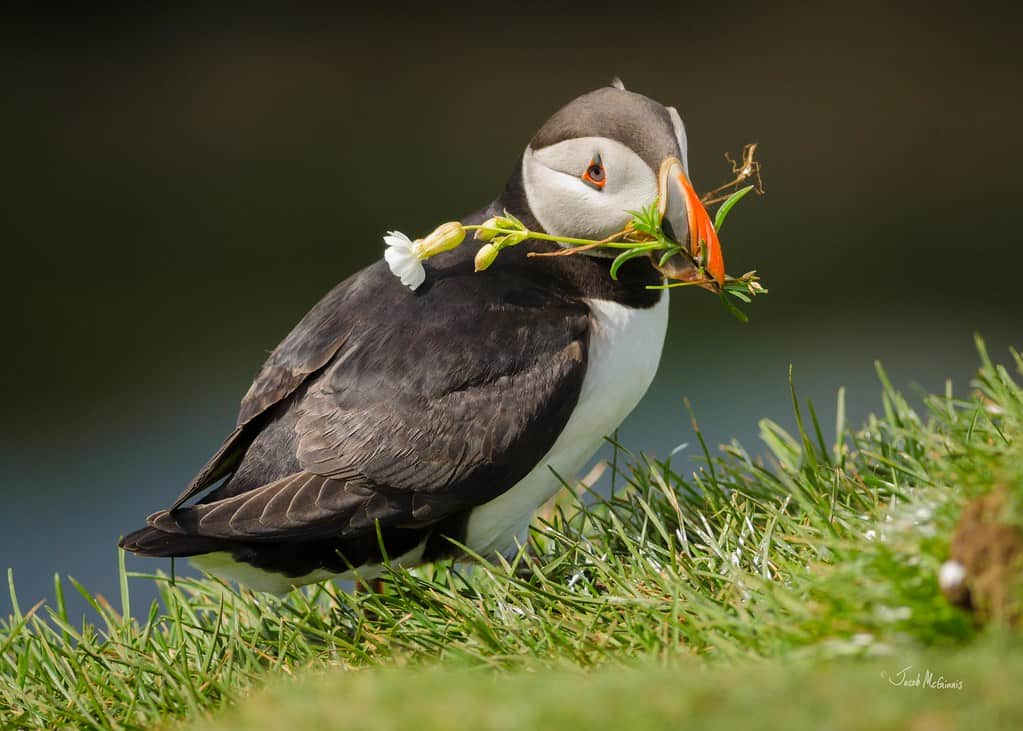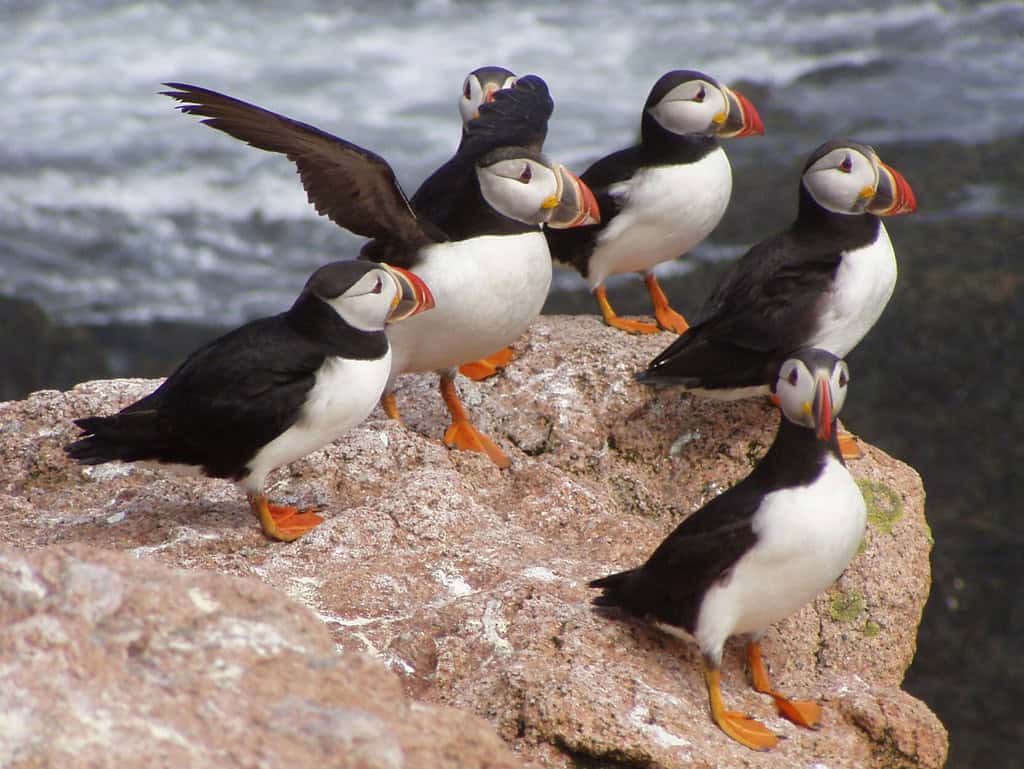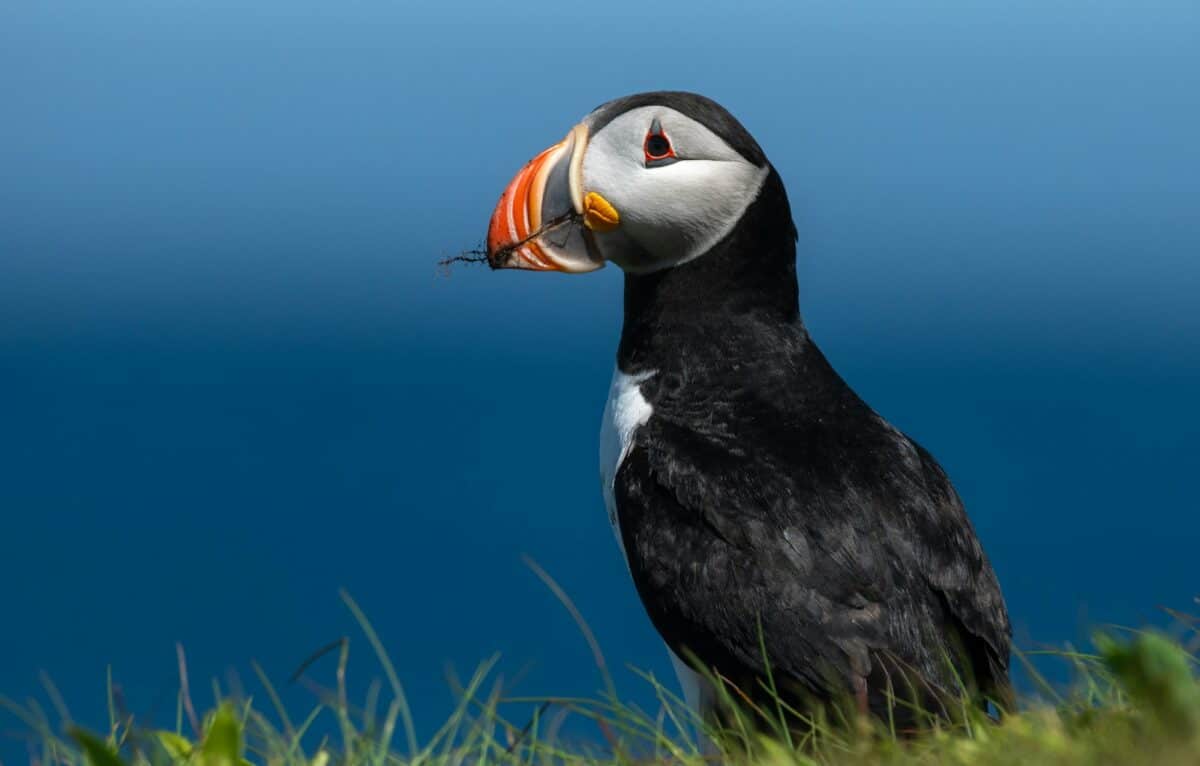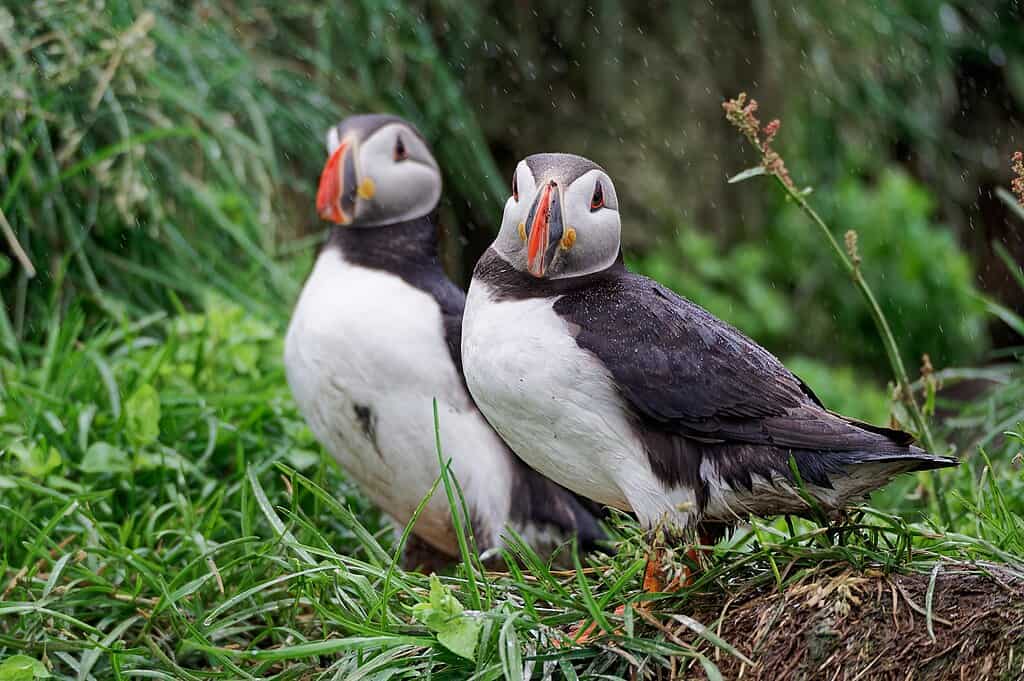Atlantic Puffins (Fratercula arctica), with their distinctive colorful beaks and charming penguin-like appearance, captivate wildlife enthusiasts around the world. These seabirds, often called “sea parrots” or “clowns of the sea,” spend most of their lives on the open ocean but return to land for their summer breeding season. In the United States, puffin nesting sites are limited to a handful of protected islands off the coast of Maine, making these locations particularly special for birdwatchers and nature lovers.
The history of puffins in the U.S. is a remarkable conservation success story. By the late 19th century, puffins had been hunted to near extinction along the Maine coast for their meat, eggs, and feathers. Through dedicated conservation efforts beginning in the 1970s with Project Puffin, these charismatic birds have been successfully reintroduced to their historic nesting grounds. Today, visitors have the rare opportunity to observe these enchanting seabirds in their natural habitat during the breeding season, typically from April through August.
Eastern Egg Rock: The Pioneer Puffin Colony

Eastern Egg Rock, a small, treeless island located about six miles from mainland Maine in Muscongus Bay, holds a special place in puffin conservation history. This island became the site of the world’s first seabird restoration project in 1973 when Dr. Stephen Kress of the National Audubon Society began efforts to restore Atlantic Puffins to their former breeding grounds. Today, Eastern Egg Rock supports a thriving colony of approximately 150 breeding pairs of puffins, making it an important success story in wildlife conservation.
Visitors can observe the Eastern Egg Rock puffin colony via boat tours that operate from nearby coastal towns including New Harbor, Boothbay Harbor, and Port Clyde. These tours typically run from late May through August when puffins are actively nesting and feeding their young. While landing on the island is prohibited to protect the birds, the boats circle at a respectful distance that still allows for excellent viewing opportunities and photography, especially when the puffins are making frequent flights to deliver fish to their chicks.
Machias Seal Island: The Largest Accessible Puffin Colony

Machias Seal Island, located at the mouth of the Bay of Fundy approximately 10 miles offshore from Cutler, Maine, hosts the largest and most accessible puffin colony in the United States. This 20-acre island is home to approximately 5,000-6,000 pairs of nesting puffins during the summer months. What makes this location particularly special is that it’s the only puffin nesting site where visitors can potentially land on the island and observe the birds from close quarters within specially constructed blinds.
The island’s status is unique as it’s claimed by both the United States and Canada in a friendly territorial dispute that has continued for decades. While this diplomatic curiosity persists, the real draw is the extraordinary wildlife viewing experience. Tour operators from both Cutler, Maine and Grand Manan Island, New Brunswick offer trips to the island during the breeding season. These excursions are highly sought after, with limited daily landings permitted and spots typically booking months in advance. Weather conditions can affect landing possibilities, but even when landings aren’t possible, boat tours circle the island for excellent viewing opportunities.
Petit Manan Island: A Protected Wildlife Refuge

Petit Manan Island is part of the Maine Coastal Islands National Wildlife Refuge and serves as another important nesting site for Atlantic Puffins. Located about two miles off the coast of Steuben, Maine, this island provides critical habitat not only for puffins but also for other seabirds including terns, razorbills, and guillemots. Conservation efforts have helped establish a small but stable puffin colony here, contributing to the overall recovery of the species in the United States.
While direct landings on Petit Manan are not permitted due to its protected status as a wildlife refuge, several tour operators from nearby communities offer boat tours that provide good opportunities to observe the puffins from the water. The island is recognizable by its tall lighthouse, which at 119 feet is the second-tallest lighthouse in Maine. The best time to visit is from mid-May through July when adult puffins are busily feeding their growing chicks, making frequent trips between their burrows and the sea.
Matinicus Rock: A Historic Puffin Haven

Matinicus Rock, located 23 miles offshore from Rockland, Maine, is one of the most remote and historically significant puffin nesting sites in the United States. This 22-acre island has hosted puffin colonies for centuries and was one of the few locations where these birds managed to maintain a foothold even during the period of their near-extinction in Maine. Today, the island supports approximately 300 pairs of nesting puffins along with significant populations of other seabirds including Arctic and Common Terns, Razorbills, and Common Murres.
The island’s isolation has helped protect its bird populations, though it also makes it more challenging to visit. No regular commercial tours land on the island, but several operators offer boat trips that circle Matinicus Rock, providing good viewing opportunities without disturbing the nesting birds. The island’s rich history includes the heroic story of Abbie Burgess, who as a teenager in the 1850s maintained the island’s lighthouse during a month-long winter storm while caring for her family. This combination of natural and human history makes Matinicus Rock a particularly fascinating destination for those interested in Maine’s maritime heritage as well as its wildlife.
Seal Island National Wildlife Refuge: A Restored Ecosystem

Seal Island National Wildlife Refuge, located about 22 miles south of Rockland in Penobscot Bay, represents another remarkable success story in puffin restoration. This 65-acre island was once home to a thriving puffin colony before hunting and habitat disruption eliminated the birds by the late 1800s. In 1984, Project Puffin began efforts to reestablish puffins here, and today the island hosts approximately 500 breeding pairs, making it one of the largest puffin colonies in the United States.
Like other protected islands, Seal Island does not permit public landings, but the surrounding waters are accessible by boat. Several tour operators from Rockland and nearby harbors offer puffin-watching excursions that circle the island during the breeding season. In addition to puffins, visitors might observe other seabirds and marine wildlife including seals, porpoises, and occasionally whales. The island also has historic significance as a former Navy outpost during World War II, with some remnants of military structures still visible along its shores.
Best Times to See Puffins in the United States

The window for observing Atlantic Puffins in the United States is relatively narrow, aligned with their breeding season. Puffins begin returning to their nesting islands in Maine in April, with the population building through May as birds arrive from their winter at sea. The peak viewing period runs from June through mid-August, when adult puffins are actively nesting and feeding their chicks. During this time, the birds make frequent trips between their burrows and fishing grounds, providing excellent opportunities for observation.
July is generally considered the optimal month for puffin watching, as this is when chick-feeding activity reaches its height. By late August, the young puffins (called pufflings) begin to fledge and adult birds start to depart the colonies, returning to their life on the open ocean. Weather conditions can significantly impact viewing opportunities, with calm seas and clear days offering the best experience. Most tour operators recommend making reservations well in advance, especially for the limited landing permits available for Machias Seal Island, which often book up months ahead for the prime summer season.
Planning Your Puffin-Watching Trip

Planning a successful puffin-watching expedition requires some preparation. Most puffin tours depart from small coastal communities in Maine including Boothbay Harbor, New Harbor, Port Clyde, Rockland, Bar Harbor, and Cutler. These tours vary in duration from 2-5 hours depending on the destination and typically cost between $50-$150 per person, with trips to more remote islands or those offering landing opportunities commanding higher prices. Reservations are essential, especially during peak summer months when demand is highest.
When preparing for your trip, it’s advisable to bring binoculars, a camera with a telephoto lens, sunscreen, and layered clothing as temperatures on the water can be significantly cooler than on the mainland. Many operators recommend taking motion sickness medication, even for those who don’t typically experience seasickness, as waters around the islands can be choppy. Additionally, flexibility in your schedule is helpful, as tours may be canceled due to fog, high winds, or rough seas. Most reputable tour companies offer weather-related cancellations with the option to reschedule or receive a refund.
Puffin Behavior and Nesting Habits

Understanding puffin behavior enhances the viewing experience. Atlantic Puffins typically mate for life and return to the same nesting burrow year after year. Unlike many seabirds that nest in exposed areas, puffins dig burrows into soil or utilize crevices among rocks where they lay a single egg. Both parents share incubation duties for approximately 39-43 days before the chick hatches. During your visit, you might observe puffins carrying multiple fish crosswise in their beaks—an impressive feat made possible by specialized serrations on their bills and tongues that allow them to hold several fish at once while continuing to hunt.
When watching puffins, you’ll likely notice their distinctive waddling gait on land, contrasting with their remarkable agility in water and air. Puffins are excellent swimmers, using their wings to “fly” underwater to depths of up to 200 feet when hunting for small fish. Their colorful bills become most vibrant during breeding season and fade to a duller color in winter. Patient observers may witness puffins engaging in bill-tapping courtship behaviors, territorial displays, or the busy activity of feeding chicks. These glimpses into puffin life cycles make the viewing experience particularly rewarding for nature enthusiasts.
Conservation Efforts and Ethical Viewing

The presence of Atlantic Puffins along the Maine coast today is a direct result of intensive conservation efforts, particularly the pioneering work of Project Puffin, initiated by Dr. Stephen Kress and the National Audubon Society in the 1970s. These efforts involved translocating puffin chicks from stable populations in Newfoundland to historic nesting sites in Maine, along with the use of social attraction techniques including decoys and sound recordings to encourage the birds to recolonize. Today, ongoing conservation work includes monitoring, habitat management, and protection from disturbance and predation.
Ethical viewing practices are essential to ensure these conservation gains aren’t undermined by tourism. Responsible tour operators maintain appropriate distances from nesting areas, limit time spent near colonies, and educate visitors about minimizing their impact. As a visitor, you can contribute to puffin conservation by choosing operators with strong environmental ethics, following all guidelines during your trip, and considering a donation to organizations like the National Audubon Society that continue vital seabird conservation work. Remember that your visit not only provides a memorable wildlife experience but also generates economic support for conservation through sustainable ecotourism.
Beyond Maine: Other U.S. Puffin Viewing Opportunities

While Maine hosts the only Atlantic Puffin colonies in the United States, birdwatchers interested in seeing other puffin species have limited options elsewhere in the country. Alaska offers opportunities to view Horned Puffins (Fratercula corniculata) and Tufted Puffins (Fratercula cirrhata) at locations including the Pribilof Islands, Kenai Fjords National Park, and the Alaska Maritime National Wildlife Refuge. These Pacific puffin species differ from their Atlantic cousins in appearance but share many behavioral traits and are equally captivating to observe.
Winter pelagic (open ocean) birding trips off the coasts of Massachusetts, Rhode Island, and occasionally as far south as New Jersey may occasionally encounter Atlantic Puffins in their winter plumage, though sightings are unpredictable and the birds lack their distinctive colorful breeding bills during this season. For those unable to visit active nesting colonies, several excellent aquariums and zoos across the country maintain puffin exhibits, including the New England Aquarium in Boston and the Oregon Coast Aquarium, providing educational viewing opportunities year-round.
Conclusion: The Magic of Puffin Encounters

Witnessing Atlantic Puffins in their natural habitat along the Maine coast offers a rare window into one of nature’s most charming and resilient species. These encounters represent more than just a wildlife viewing opportunity; they’re a celebration of successful conservation that brought a species back from the brink of local extinction. The limited availability of puffin nesting sites in the United States makes these experiences particularly precious, creating memories that last long after visitors return to the mainland.
For many wildlife enthusiasts, seeing puffins in their breeding colonies becomes a highlight of their nature-watching experiences, combining the thrill of spotting these charismatic birds with the satisfaction of supporting their ongoing conservation. The seasonal nature of puffin presence in U.S. waters adds to their mystique, as these birds spend the majority of their lives far from human eyes on the open ocean. Whether you’re an avid birder checking a species off your life list or simply someone drawn to these appealing “sea parrots,” a puffin-watching expedition to Maine’s special islands offers an unforgettable connection to the natural world and the successful efforts to preserve it for future generations.
- How Penguins Take Turns at Sea and Nest to Raise Chicks - August 9, 2025
- Dolphin Brains Compare to Those of Apes and Humans - August 9, 2025
- 14 Cutting-Edge Biotech Innovations That Will Shape the Future - August 9, 2025

